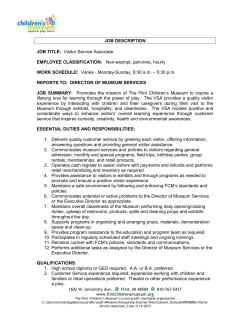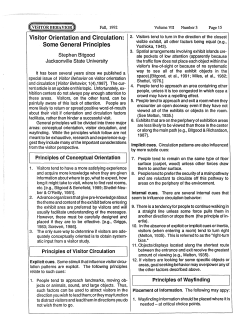
How to facilitate visitors interacting at exhibits
How to facilitate visitors interacting with exhibits You are the most important interactive on the floor for the visitors, but only if you are genuinely interactive with them. Interacting or being open to interacting with people constantly on the exhibition floor is very tiring if you are doing it properly. It can also take time to develop the confidence to do it effectively with a wide range of visitors. If you close yourself off from visitors through your body language and attitude, your time on the exhibition floor may seem “easier”, but it gets boring and tedious very quickly. If you don’t like people and enjoy interacting playfully and patiently with them, you’re probably not suited to the important job of working on the exhibition floor. Before you interact Judge carefully when to approach a visitor who may appear to be ‘stuck’ One of your main roles is to nurture the self-esteem and confidence of the visitor – to empower them to discover things for themselves. If they cannot get an exhibit ‘to work’ (ie do what they “think” it should do) they will probably walk away from the exhibit feeling either frustrated or incompetent. We want to prevent both of these situations where we can, so if you judge that a visitor is becoming frustrated you should gently prompt them to see if they would like any help or perhaps suggest an activity that they could try. Don’t prejudge visitors as you approach them Don’t assume anything about our visitors. Beware of stereotypes. Avoid the ‘shop assistant’ scenario Remember how you feel when you are quietly browsing in a shop, and eager shop assistants keep approaching you, asking if they can help. This is how many visitors feel when they see you approach. Imagine if these shop assistants went further and starting asking you technical questions about how the items you were looking at were made or how they work. Avoid the ‘group of shop assistants’ scenario There is only one thing more intimidating than a shop assistant pestering you – a group of shop assistants standing around in groups talking and laughing. Don’t have long conversations with other staff members on the exhibition floor. It gives the impression you are bored and not interesting in interacting with the visitors – they should be your major concern. © learn differently ltd 2015 Making the first connection Your attitude will be infectious for visitors The underlying messages in your approach to learning and discovery are an important part of the visitor’s experience. If you can spark an interest in a visitor, this reaction can have much more profound and long-lasting affects than simply communicating factual information to that visitor. Rule number 1 - do not try to take over from the visitor Don’t do for the visitor anything that they could easily have done for themselves. You should quietly facilitate their process of discovery, not take control away from the visitor. Your role requires a lot of sensitivity and patience towards the visitors and the situation. Keep your hands in your pockets, so to speak, and wait until they ask. Let them make mistakes for themselves – it’s part of their process of discovery and learning. If you notice the visitors all staring at you rather than the exhibit this is almost always a bad sign – try to be less demonstrative and refocus their attention on the exhibit. Remember you’re both human Often the best way to engage any visitor is to talk to them in a friendly, general way about their visit/ who they are with/ parking/ the weather - having a short sociable conversation like humans do all the time – rather than launching into an insightful explanation of the exhibit they happen to be innocently resting against. Visitors come to our centre for very diverse reasons. While you interact Do not do anything to make visitors feel patronised or foolish Remember it is very easy to appear patronising to visitors who are confused and uncertain. Be natural, friendly and relaxed - try to put people at their ease as quickly as possible. You are there to help them get the most out of their experience. Explain through questions and playing rather than telling Fight your urge to explain how every exhibit works to every visitor. Instead use simple questions to encourage the visitor to think about and explore what kinds of things they could do with the exhibit; how it might work; who might have used the object in the past. Encourage them to play and enjoy the emotions they are feeling in their own right. Ideally you want to build a relationship with the visitor – if you only offer factual answers to curious questions, you immediately make yourself the expert. We do not want to be seen as experts. However, if you answer a question with another question or suggest an activity that they might try to help answer the question, you are then giving responsibility back to the visitor. © learn differently ltd 2015 Build on what the current knowledge and understanding of the visitor We all have preconceived ideas about many everyday events and phenomena – some ideas may agree with current scientific thinking, some may not. Exhibits can help us to question some of these ideas, and with your help the visitor may be able to take on some alternative explanations. But you must start from where the visitor is in their current understanding, not from where you are, or from where you think they should be. Watch your language Be careful that you use a level of language that is appropriate to your audience. Many visitors may not have your understanding of many technical and non-technical words. This sounds obvious, but it is surprisingly difficult to explain even a basic concept in simple, jargon-free language. It is a skill that takes a long time to develop. Watch you audience carefully to see if they appear to understand; use rephrasing to help to clarify your meaning; always introduce jargon with a more accessible explanation; use pauses to invite feedback. Help visitors to connect the exhibit to their everyday life Examples of science and technology surround each of us in our daily lives. It is important to encourage visitors to connect the phenomena they have just been playing with to situations outside the museum – through questions or telling stories. Use concrete examples that are likely to be familiar to the visitor and be prepared for children to reply with more stories. Don’t answer questions that visitors have not asked yet Listen carefully to what the visitor says and the questions he asks. Make sure any explanations that you do give are short, relevant and as clear as possible – ‘sound bites’ rather than lectures. Visitors will want to explore and interact, not listen to you discuss your favourite aspect of aerodynamics. Don’t be surprised if they walk away from you in mid-lecture. Visitors frequently use exhibits in ways their designers may not have intended – this is OK The most effective, open-ended exhibits work in many different ways and on different levels. Visitors are amazingly creative and imaginative – encourage them to explore and question safely in whatever directions they are interested. © learn differently ltd 2015 Remember that you can learn a lot from the visitors Visitors may have fresh insights and questions about particular exhibits that have never occurred to you. They may share interesting stories about times when they have experienced the phenomenon in their everyday life. Learn from these insights and stories so you can then relate them to other visitors who are interested. We are not experts – it’s alright to say ‘I don’t know’. Honestly. If you are not sure about a question you have been asked, take the opportunity to demonstrate that you are learning all of the time, just like the visitor. Don’t try to bluff it and end up giving an explanation that confuses the visitor more. You should, however, have resources that you can consult to help visitors find the answer (eg other staff; online resources; reference books). It’s good to talk Try to encourage discussions amongst visitors who are in a group (a family or a group of children). Many visitors will have come to the museum primarily to spend time with their friends and family. Also much of our learning takes place in these kinds of social interactions. Be prepared to learn from other staff Watch other staff members on the floor and learn from their techniques. Regularly share tips and ideas with other members of the team. © learn differently ltd 2015
© Copyright 2025










